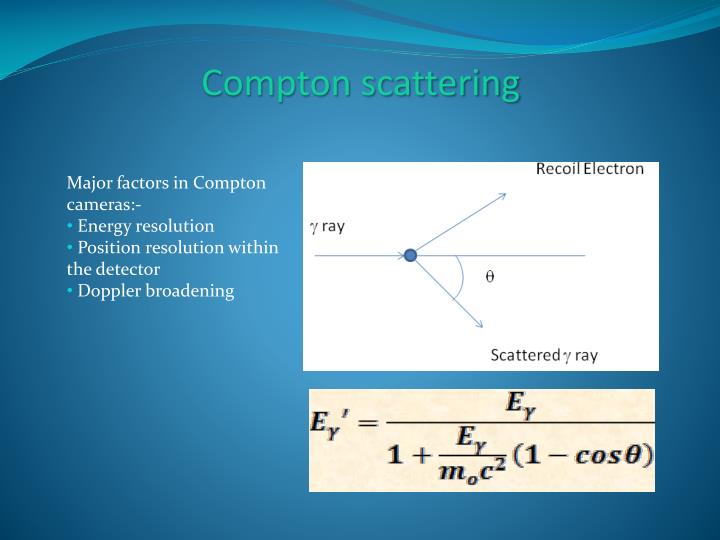

Arthur Compton earned the 1927 Nobel Prize in Physics for the discovery. The Compton effect was observed by Arthur Holly Compton in 1923 and further verified by his graduate student Y. Although nuclear compton scattering exists, Compton scattering usually refers to the interaction involving only the electrons of an atom. The amount the wavelength changes by is called the Compton shift. Inverse Compton scattering also exists, where the photon gains energy (decreasing in wavelength) upon interaction with matter. ISBN: 978-2759800414.In physics, Compton scattering or the Compton effect is the decrease in energy (increase in wavelength) of an X-ray or gamma ray photon, when it interacts with matter. Robert Reed Burn, Introduction to Nuclear Reactor Operation, 1988.Nuclear Reactor Engineering: Reactor Systems Engineering, Springer 4th edition, 1994, ISBN: 978-0412985317 Stacey, Nuclear Reactor Physics, John Wiley & Sons, 2001, ISBN: 0- 471-39127-1. Baratta, Introduction to Nuclear Engineering, 3d ed., Prentice-Hall, 2001, ISBN: 8-1. Lamarsh, Introduction to Nuclear Reactor Theory, 2nd ed., Addison-Wesley, Reading, MA (1983). DOE Fundamentals Handbook, Volume 1 and 2. Department of Energy, Nuclear Physics and Reactor Theory. Martin, James E., Physics for Radiation Protection 3rd Edition, Wiley-VCH, 4/2013.Stabin, Michael G., Radiation Protection and Dosimetry: An Introduction to Health Physics, Springer, 10/2010.Knoll, Glenn F., Radiation Detection and Measurement 4th Edition, Wiley, 8/2010.The photoelectric absorbtion dominates at low-energies of X-rays, while Compton scattering dominates at higher energies. The strength of these interactions depends on the energy of the X-rays and the elemental composition of the material, but not much on chemical properties, since the X-ray photon energy is much higher than chemical binding energies. Interaction of X-rays with MatterĪlthough a large number of possible interactions are known, there are three key interaction mechanisms with matter. The quantity h/m ec is known as the Compton wavelength of the electron and is equal to 2.43×10 −12 m. The maximum change in wavelength can be derived from Compton formula:

In this case the photon transfers to the electron as much momentum as possible. The maximum change in wavelength ( λ′ − λ) for the photon occurs when Θ = 180° (cos(Θ)=-1). The minimum change in wavelength ( λ′ − λ) for the photon occurs when Θ = 0° (cos(Θ)=1) and is at least zero. Where λ is the initial wavelength of photon λ’ is the wavelength after scattering, h is the Planck constant = 6.626 x 10 -34 J.s, m e is the electron rest mass (0.511 MeV) c is the speed of light Θ is the scattering angle. The shift of the wavelength increased with scattering angle according to the Compton formula: So the decrease in photon’s momentum must be translated into decrease in frequency (increase in wavelength Δ λ = λ’ – λ). This deflection results in a decrease in energy (decrease in photon’s frequency) of the photon and is called the Compton effect. In Compton scattering, the incident gamma-ray photon is deflected through an angle Θ with respect to its original direction. As a result of momentum conservation law, the photon must lower its momentum given by: While the electron gains momentum (mass x velocity), the photon cannot lower its velocity. Upon collision, the photon bounces off electron, giving up some of its initial energy (given by Planck’s formula E=hf). In the case of Compton scattering the photon of frequency f collides with an electron at rest.

Compton scattering formula is the mathematical relationship between the shift in wavelength and the scattering angle of the X-rays. Compton explained that the X-ray shift is caused by particle-like momentum of photons. The Compton formula was published in 1923 in the Physical Review.


 0 kommentar(er)
0 kommentar(er)
